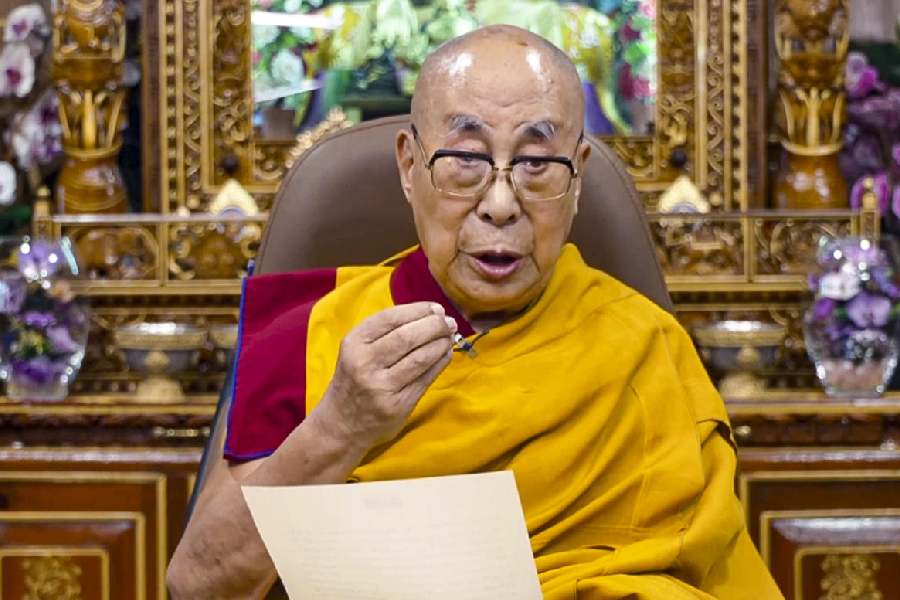 |
| Deepta Roy (left) and Ipsita Roy Chakraverti at Oxford Bookstore. Picture by Sanjoy Chattopadhyaya. |
 |
| Paulo Coelho |
 |
| Shirshendu Mukhopadhyay and Nirmal Kanti Bhattacharjee (left) at the launch. Picture by Aranya Sen |
 |
| Mohar Kunja |
There’s more to Paulo Coelho than meets the eye. The Brazilian writer whose bestselling books are said to have a life-enhancing effect on millions across the world is a “wiccan” and a “mystic”. Coelho’s wicca link was brought under the scanner by Calcutta’s own wiccan Ipsita Roy Chakraverti at a book-reading session of his latest release Brida.
Not only does Brida dwell on wicca, Coelho himself is a practitioner of the pagan religion that worshipped the Mother Goddess around 25,000 years ago, confirmed Ipsita.
“Coelho writes, ‘At that time, however, God had been a woman’. He invokes Virgin Mary who was once considered to be a pagan goddess. Brida is a book on wicca and Coelho is a wiccan. And it’s not surprising because several writers were known to be wiccans, like Arthur Conan Doyle and WB Yeats,” said Ipsita, at Oxford Bookstore on Friday.
Coelho had written Brida in 1990; the English translation was launched early this year. The book is about Brida O’Fern, a young Irish girl who roams the forests in search of someone who would teach her occult, magic and the esoteric arts.
On a spiritual quest to find her Soulmate, Brida first meets Magus, a magician, and then a character called Wicca, who teaches her the Tradition of the Moon. At the end of her journey, she learns to balance spirituality with love and passion.
In Brida, Coelho makes explicit use of concepts and tools of the woman-centric pagan religion. According to Ipsita, he has borrowed his heroine’s name from Bridgette, or Brida, the Irish goddess of wicca who symbolises the transformation of the soul. He refers to the wise women of old, the return to nature in order to gain knowledge, the vibrations of the earth, the circle of wicca and its underlying philosophy “to accept and move on”.
“Coelho has also drawn upon various traditions from across the world. There are concepts from the Rig Veda, Taosim, the Shinto religion in Japan and the Indian Tantric cult. It’s a beautiful amalgamation of the east and the west,” added Ipsita, who has revived the study of the ancient esoteric arts and civilisations in Calcutta through the Wiccan Brigade.
Ipsita was accompanied by her corporate lawyer daughter Deepta Roy who threw light on the growing interest in spirituality and wicca among the youth. “It inculcates discipline and a deeper understanding which acts as a kind of renewal and revival in our busy life,” said Deepta.
The writer of The Alchemist too inspires renewal and revival.
A hair-raising evening
Taking up cudgels for ghosts, author Shirshendu Mukhopadhyay said: “You don’t have to believe in them and at the same time you don’t have to shut them out. There are many things that science cannot yet fathom.” And he should know for it was his 200-year-old ghost of Gosain Bagan that held the audience captive on a sweltering Wednesday evening at Oxford Bookstore.
The occasion was the launch of The Ghost of Gosain Bagan, which is an English translation by Nirmal Kanti Bhattacharjee of Mukhopadhyay’s popular Bengali children’s novel Gosain Baganer Bhoot published by Ponytale Books. The book narrates the adventures of Burun, who having been scolded for failing his maths test, walks off into the terrifying ghost-infested Gosain Bagan. Not unexpectedly Burun is accosted by a 200-year-old ghost, who can walk over water, take off his head at will and perform all the hair-raising antics of a normal ghost. There is just one problem though. Burun is in no mood to be scared. It is up to ghost Nidhiram, a trusted henchman of dacoit Gosain, to lift Burun out of his depression and scare him out of his wits thus saving face before his bhoot clan.
The author and the translator took turns reading out excerpts from the two versions. Bhattacharjee, who is also director of National Book Trust (NBT) and regional secretary of Sahitya Academy, said that though he was well past his childhood when he read the book, he was so overwhelmed by it that he included it in the NBT’s translation list. The project fell through though but he seized the first opportunity to translate the text. Like all translators, Bhattacharjee had had to take liberties (like cutting off Goshto Pal’s name because today’s kids wouldn’t know of him) but his translation was otherwise true to the original text.
The session ended with Shirshendu Mukhopadhyay narrating his other-worldly experiences with the memsahib bhoot of his childhood home in Katihar. The graceful clatter of her high heels had haunted him for three years around the colonial bungalow. “Gosain Bagan was my second novel probably published in the mid-1970s, but ghosts have always been a part of my fiction, I bring them in whenever it suits me as I did in Gainar Baksho for instance. To me ghosts are characters like other living characters. Only they are capable of doing things, no human being can. I don’t think children who read Harry Potter should have any reservations about my ghosts,” Mukhopadhyay told The Telegraph after the event.
Unworthy tribute
Mohar was the pet name of the Rabindrasangeet singer Kanika Bandopadhyay, still considered one of the best in this rarefied field. The poet himself had named her thus in appreciation of the sterling quality of her voice. In this state we love to name any city landmark either after the poet or those associated with him. We consider that our tribute to his genius, typically overlooking the quality — or lack of it — of the tribute itself. Anybody who has seen Mohar Kunja created outside the Victoria Memorial Hall grounds opposite the Academy of Fine Arts will realise that this cramped little garden crammed with little pieces of concrete impediments is hardly anything to write home about, leave alone worthy of paying a tribute to a singer of Kanika Bandopadhyay’s stature.
In the evening, it dazzles like a Christmas tree with a thousand lights that line the narrow pathways. A fountain is lit with rainbow colours. Surely good Bengalis don’t associate Rabindrasangeet in its purest form with this piece of pure kitsch. Mohar Kunja is just another eyesore, one of the many that will soon overwhelm this city.
Laboured language
When the Christian missionaries began to pick up Bengali in the 19th century they often confused turns of phrase, sometimes with embarrassing results. Even when The Bible was translated into Bengali the sentences sounded stiff and jejune, quite at variance with the syntax of the language. The language of public awareness programmes prepared by the Centre and broadcast by All India Radio sound quite as laboured.
FM Rainbow, for example, broadcasts programmes on alternative energy sources and the importance of eyecare. Quite obviously translated from Hindi by people who have no idea of the rhythm of Bengali as she is spoken, initially they sound hilarious. Then amusement turns into irritation and finally anger as one realises that precious public funds are being wasted on such rubbish.
Why don’t the people in Delhi employ people who know the Bengali language better? Or they should put a stop to such programmes altogether.
(Contributed by Reshmi Sengupta, Sebanti Sarkar and Soumitra Das)










